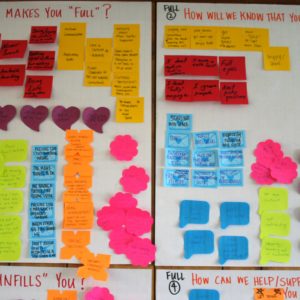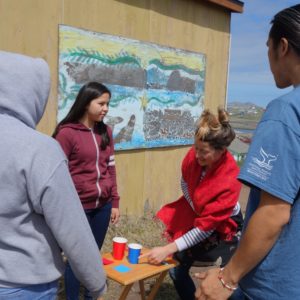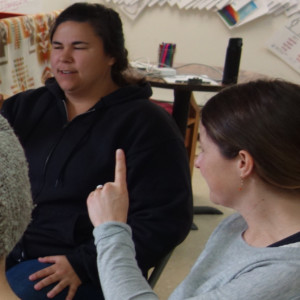
We now live in a time where, in the next 5-10 years, we will see a massive die-off of language diversity as globalization and modern forces have their final impacts among aging speakers of the world’s traditional, wisdom-bearing, indigenous languages. Unless we act now.
In this article, following forward from the triage of a particular language’s need, Evan and I look at what it takes to turn around the momentum of a language; from more or less inevitable extinction through loss of aging fluent speakers, transformed into a self-sustaining, vital, generative learning community that creates more “Superior” level speakers every year at an accelerating rate.
We strongly believe that, though documentation and recording of fluent speakers by linguists provides valuable historical information, it does not address a fundamental issue:
In order for a language to survive, an increasing group of people must start having conversations in that language right now, and they must continually in day-to-day conversation, from the first moment, work to increase their fluent proficiency level, and the overall fluent proficiency of their community.
We don’t revitalize language when we archive and document them, or when we create written orthographies, or translate literature; we revitalize a language when we converse in it. First and foremost, revitalization begins with daily oral culture.
So, to support a community’s decision to radically transform its momentum, using the fluency game, we have to make several more assessments of the language and its community:
How complex is the language? If it is a language with a lot of up-front complexity, like Kiksht or Hungarian, we’ll spend more time building a stronger base at the beginning (though this will pay off later as the community moves through higher proficiency levels on its own). This means a greater initial time investment.
How diffuse is the community? How much of a diaspora exists? If the community has a densely populated core, with frequent and well attended social events, this profoundly supports the work. This doesn’t refer to the fluent speaker population, but the population of potential fluent speakers. In order to really drive the game and turn around the destiny of a language, you need a community to enact this transformation. The smaller and more diffuse the community, the more work this will take.
How many willing fluent speakers exist? Like in any small community, politics, feuds, and personalities play a large role in how many truly available fluent speakers can support revitalization. What if the fluent speakers don’t like each other? What if they’re very private people? Culturally, what if humility and reserve limit their willingness to participate in an (admittedly) highly social, noisy, interactive language game? Perhaps (for example) 50 fluent Superior speakers then become, in actuality, 10 speakers who can realistically participate in revitalization (at least in the initial stages). Or 10 speakers may then become 1. This kind of assessment, though a hard pill to swallow, helps us to create a realistic picture of just how much up-front time we need to invest to transform the momentum of a language and support the realization of a bright future, rather than a tragic one.
How many community members become key revitalizers? Since we purpose to have the community carry the expertise and competency to revitalize their own language, inevitably we’ll need key members who stand out in terms of participating in conversations, showing grassroots leadership, and role-modeling a level of commitment required to revitalize their language. Evan and I will only participate long enough in a community’s language revitalization to unload the grassroots skill-set of WAYK; who then takes over after we leave? We groom these key players from the start, and if they don’t show up, if the general community doesn’t show enough commitment early in the process, that means more time invested on our part to find those key revitalizers that will create the momentum.
An example case. We’ve spent the past few weeks assessing several local Pacific Northwest native languages. Here we offer one assessment from that batch. Looking at the above factors (complexity, community core, willing fluent speakers, key revitalizers), we have estimated a “Superior” level language death of the language in 4 years, and “Advanced”/”Intermediate” level death (and thus the death of the language itself, as the language can’t feasibly revive from “Novice” level) in 6 years. This particular estimate, though certainly grim, perhaps counter-intuitively also reveals a lot of opportunity, as this particular community has a lot of key strengths that will carry the language farther than it might otherwise, in spite of a very small population of fluent “Superior” speakers.
So, for this example language, what will it take to turn its destiny around?
After 8 weeks of the community working with WAYK, we predict a full (near 100%) momentum change for the language, assuming the following community actions:
- Every weekend during that time, Evan and I hold a Saturday and Sunday teacher-training WAYK workshop.
- Every week, three times a week (Mondays, Wednesdays, Fridays), the community holds a two hour conversation group, preferably centered around a cultural activity/event (basketry, drumming, cooking, canoeing, harvesting/making medicine, etc.).
- Every conversation evening run by at least three different game leaders/teachers, one for each night (Monday Teacher A, Wednesday Teacher B, Friday Teacher C).
So, when we say “near 100% momentum change”, what do we mean? What does a change in momentum look like? We essentially mean that the community has taken on new habits, as a language community, and that they have a minimum grassroots language learning toolkit to make the most of those new habits.
- The community has a regular, scheduled conversation space, several evenings a week, in which to speak their language. This, frankly, is the most difficult piece to accomplish, and a very big deal, as any community organizer can attest.
- At least 5 key community members have gone up one sub-level on the “Travels with Charlie”/ACTFL scale; Novices go to Intermediate-low, Intermediate-low goes to Intermediate-mid, Intermediate-mid goes to Intermediate-high, Intermediate-high goes to Advanced-low, etc. In doing so they’ve gained the essential grasp of the WAYK game.
- In this case, for our example language, this then generates a self-sustaining population of “Superior” speakers in approximately 3 years.
Of course, Evan and I don’t have a crystal ball; all kinds of chaotic events can and do happen, and we’ve made these estimates as conservatively as possible. Barring any truly unusual events, like civil wars, tsunamis, or even immortality pills, we stand by these estimates. In the end, the most fragile element in the equation comes down to the fluent, elderly, “Superior” speakers. Beyond their value as community elders, family, and unique people with their own talents and gifts (such as jazz musician Edward Tatoosh), they are truly the future of the language.






“Evan and I will only participate long enough in a community’s language revitalization to unload the grassroots skill-set of WAYK; who then takes over after we leave?”
I’ve found myself in this particular situation with my own community, and it has been a learning experience about what skills I needed (and need) to develop to make this successful.
I have thought about it almost in terms of there being shadow-WAYK techniques to learn, things you do that help or hinder a community’s ability to show up and play.
Unfortunately, some of these learning experiences have come at the expense of my loosing players. This gives me a particular sense of urgency with regard to figuring out how to successfully manage a community of players, particularly in the early, formative stages of teaching and playing the game.
I’ve found myself doing offline prep work and study before sessions, as well as spending time practicing solitary to make sure that I’m prepared, enthusiastic, and ready to teach when I’m in front of people. I still want to improve my fluency at managing the flow of the game and ensure every player comes away with something exciting they learned.
With regard to your comment above, I’ve been spending time developing my coaching skills, practicing peer coaching with other interested friends and applying “technique: technique” to rapidly gain fluency in coaching techniques.
My personal experience suggests that there is a role for you and Evan in a periodic but ongoing basis with communities in which you’ve seeded WAYK. Namely, providing coaching and check-in, even over phone or e-mail, to those who have assumed a greater responsibility in organizing WAYK sessions.
Alan-
Our experiences definitely reflects your own. Though the community itself must perform the bulk of the organizing and play, we still see a need for checking back in, fine tuning and so on, until enough communities can interdepend on each other to do this work, from their different experiences and particular gifts as different groups of people.
In other words, we still hope to make ourselves obsolete, but that means creating enough sustainable populations of fluency game communities, so that they can converse and coach each other.
In your case, you didn’t receive the “momentum building” necessary that plays a critical role (and that we’ve described above for more high-stakes situations than yours). This happened of course because of limited resources on all our parts, rather than a lack of commitment. So now you have a more difficult road.
In cases like yours, even though we don’t know when we’ll connect in person, we’d love to receive email updates and can provide coaching based on the challenges you experience. Definitely stay in touch!